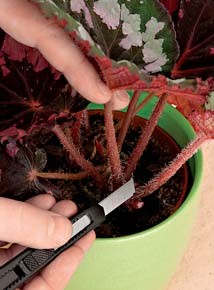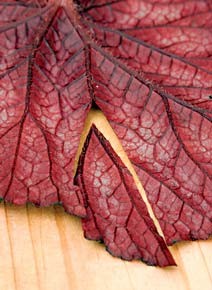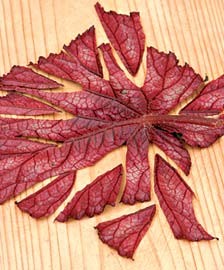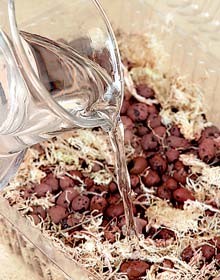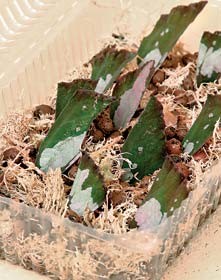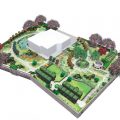photo: Anna Bershadskaya, Oleg Kulagin, Alexander Kurlovich, Vladimir Solomonov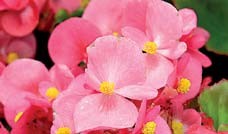 Begonia planting and care
Begonia planting and care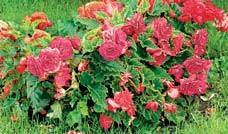 Tuber Begonia
Tuber Begonia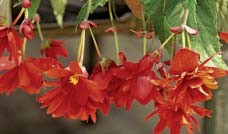 Tuberous begonia (ampelous form)In 1689Monsieur Begon, a lover and collector of rare plants, helped organize an expedition for his compatriot, botanist Charles Plumier, who went to study the flora of the West Indies. It was there that the first six species of plants of the genus named in honor of the high patron, Begonia, were discovered and described. The first species of these plants began to be grown in Europe in the 18th century. Begonia ever-flowering was discovered in Brazil in 1814, and Begonia reginae was accidentally brought to England from India along with a batch of orchids in 1856. Today, the Begonia family includes more than a thousand species of annual and perennial plants: herbs, subshrubs, shrubs and vines. And more than twelve thousand varieties and hybrids have been bred.
Tuberous begonia (ampelous form)In 1689Monsieur Begon, a lover and collector of rare plants, helped organize an expedition for his compatriot, botanist Charles Plumier, who went to study the flora of the West Indies. It was there that the first six species of plants of the genus named in honor of the high patron, Begonia, were discovered and described. The first species of these plants began to be grown in Europe in the 18th century. Begonia ever-flowering was discovered in Brazil in 1814, and Begonia reginae was accidentally brought to England from India along with a batch of orchids in 1856. Today, the Begonia family includes more than a thousand species of annual and perennial plants: herbs, subshrubs, shrubs and vines. And more than twelve thousand varieties and hybrids have been bred.
In nature
Begonias are common in the tropics and subtropics.America, Southeast Asia, Africa and on the island of Madagascar. As a rule, they can be found in damp shady places - in forests, in rock crevices, on old trees. But in the Philippines, begonias grow on limestone cliffs very close to the sea, not suffering from its salty spray: in the Andes and Himalayas they rise to a height of 4000 meters; in arid places and on rocky mountain slopes, succulent forms are found that store water in tubers. The sizes of begonias are also very diverse. Even herbaceous plants can be tiny, only 3-4 centimeters, and very large. And there are also stemless forms, they have only one leaf. Their coloring is very diverse. Leaves can be painted in all shades of green, red, purple, while the upper side remains either monochromatic or covered with yellow flowers. Begonia flowers are unisexual and monoecious. Translated from botanical, this means that female and male flowers bloom on one plant. But this does not happen at the same time (male flowers first), which allows for cross-pollination to be stimulated in natural conditions (that's what monoecious plants are). The color of the flowers is limited to a "warm" range: red, pink, white, less often - yellow and orange colors, sometimes with a greenish tint. And the seeds of this plant are extremely small. Many species contain up to 75 thousand seeds in one gram. They are practically weightless and are easily carried by the wind and rain streams.
In culture
The beauty and simplicity of vegetative propagationmade them very popular among lovers of indoor and greenhouse plants. Some begonias, such as the ever-flowering and hybrid forms of tuberous begonia (B.x tuberhybrida), moved from rooms to flower beds and became garden plants, which, by the way, feel quite good in our northern latitudes. Varietal begonias are diverse - due to the fact that natural species are constantly changing, and scientists are getting more and more new hybrids. Varietal begonias are divided into several groups - however, very conditionally. Leafy The group of leafy begonias includes mainly species of stemless plants with a creeping above-ground rhizome and leaves of various shapes and colors extending upward from it. Of the leafy begonias, the most common indoor plants are - Begonia heracleifolia and Begonia ricinifolia, as well as varieties and hybrids created on their basis. They are very unpretentious and are practically not afraid of dry room air, and they tolerate temperature changes quite easily. The most famous of the leafy begonias, the royal (B. rex), is more capricious. When caring for it, do not forget that the "queen" needs fairly high air humidity. Therefore, it is better to place the pots on wide trays with wet sand or gravel, especially if the central heating is on, and regularly spray the leaves. In addition to these species, the group of leafy ones also includes Mason's begonia (B. masoniana), Griffith's begonia (B. griffitii) and red-leaved begonia (B. erythrophylla).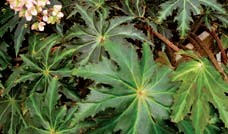 Leaf begonia borshchevikolistnaya (blackish)
Leaf begonia borshchevikolistnaya (blackish)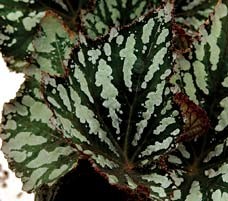 Royal Leaf Begonia
Royal Leaf Begonia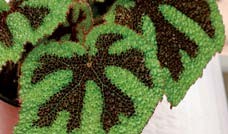 Mason's leaf begoniaBushThese are species witherect branched stem. The most hardy of them, and therefore the most common are the coral begonia (B. coralline) and the bright red begonia (B. coccinea). These plants with smooth leaves and bamboo-like geniculate erect stems are often found on the windowsills of our apartments. Other varieties and species of this group, such as the white-spotted begonia (B. albo-picta), metallic begonia (B. metallica), diadem begonia (B. diadema), incana begonia (B. incana), luxurious begonia (B. luxuriana), are less popular, and first of all, because the "water when you remember" regime is not suitable for them. Ever-blooming Ever-blooming begonia is also an unpretentious indoor plant. True, in recent years it has largely moved from windowsills to balconies and flower beds, but this is not so much a change of habitat as its expansion. After all, having become a popular annual, begonia has not lost its main qualities. It is still a beautiful unpretentious houseplant, which, justifying its name, blooms almost all summer. Recently, winter begonia (B. hiemalis hort.) has been gaining more and more recognition, blooming abundantly in winter with small bright flowers - red, orange and yellow. Tuberous This group consists of hybrid forms of tuberous begonia, with a thick underground tuber, succulent stems (among them there are ampelous, with hanging shoots) and a variety of flowers, differing in size, color and structure. Tuberous begonias are best grown in open ground: planted indoors, they turn out to be somewhat capricious - despite all their beauty.
Mason's leaf begoniaBushThese are species witherect branched stem. The most hardy of them, and therefore the most common are the coral begonia (B. coralline) and the bright red begonia (B. coccinea). These plants with smooth leaves and bamboo-like geniculate erect stems are often found on the windowsills of our apartments. Other varieties and species of this group, such as the white-spotted begonia (B. albo-picta), metallic begonia (B. metallica), diadem begonia (B. diadema), incana begonia (B. incana), luxurious begonia (B. luxuriana), are less popular, and first of all, because the "water when you remember" regime is not suitable for them. Ever-blooming Ever-blooming begonia is also an unpretentious indoor plant. True, in recent years it has largely moved from windowsills to balconies and flower beds, but this is not so much a change of habitat as its expansion. After all, having become a popular annual, begonia has not lost its main qualities. It is still a beautiful unpretentious houseplant, which, justifying its name, blooms almost all summer. Recently, winter begonia (B. hiemalis hort.) has been gaining more and more recognition, blooming abundantly in winter with small bright flowers - red, orange and yellow. Tuberous This group consists of hybrid forms of tuberous begonia, with a thick underground tuber, succulent stems (among them there are ampelous, with hanging shoots) and a variety of flowers, differing in size, color and structure. Tuberous begonias are best grown in open ground: planted indoors, they turn out to be somewhat capricious - despite all their beauty.
How to care
The species and varieties of begonias are very similar in some ways,Of course, they differ in some ways. This is what you need to take into account when caring for your plants. It can be taken as a postulate that in the summer, all begonias should be well watered. Spraying and systematic (once every 2-3 weeks) fertilization will also be appreciated by any plant of this genus. Begonias do not like bright sunlight, so they need to be shaded on southern and western windows. But ever-flowering begonias, tuberous begonias, as well as bamboo-like bush forms (white-spotted begonia, coral and bright red) tolerate the sun much easier than, for example, varieties of royal begonia, which can be burned quite easily. In winter, almost all indoor plants suffer from dry air, but begonias have a particularly hard time. Leafy begonias need more moisture than others. forms - begonias Griffith, Mason and begonia rex. Tuberous begonias, the above-ground part of which dies off for the winter, are stored in a cool place at a temperature of +10-15ºC in peat and sand. Begonias are planted, in general, in any containers - the plants are undemanding in this. The only thing worth mentioning: for forms with a creeping rhizome, choose wider pots, and for ampelous - hanging ones. By the wayIn Russia, after the war of 1812, begonia was nicknamed "Napoleon's ear" - its leaves were very reminiscent of the red frostbitten ears of French prisoners. Among other "Russian folk" names, there were "bear's ear" and "eagle's wing" - everyone has their own associations. Begonia leaves are most often shaped like "elephant ears", that is, they are strongly beveled, heart-shaped. At the same time, the central vein divides them into two unequal parts. This asymmetry is not accidental. The leaves are located on the plant in a checkerboard pattern, not shading each other and making maximum use of the sunlight penetrating through the dense crown of the tropical forest. The edges of the leaves are usually cut with teeth.
Picks and cuttings
Begonias are pricked out, that is, transplanted, selectingstrong healthy plants with a well-developed root system. It is simply necessary to do this: the plant needs enough soil and air to grow and develop. Before picking, the seedlings are carefully dug up, trying to damage their root system as little as possible. The soil mixture is well moistened, a hole is made and the seedling is lowered into it. Make sure that the root does not bend upward. Transplanted seedlings are watered with warm water - so that they take root faster. The classic composition of the soil mixture for begonias: clay-turf soil, leaf humus, peat and coarse river sand in a ratio of 2: 1: 1: 1. It is convenient to use ready-made soil mixtures made specifically for begonia. Picking What you need:
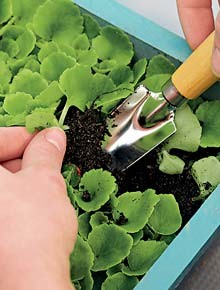
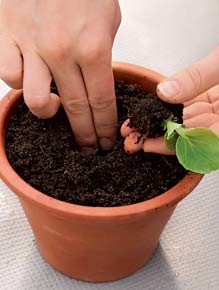
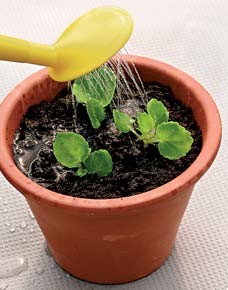
CuttingsWhat you need:
